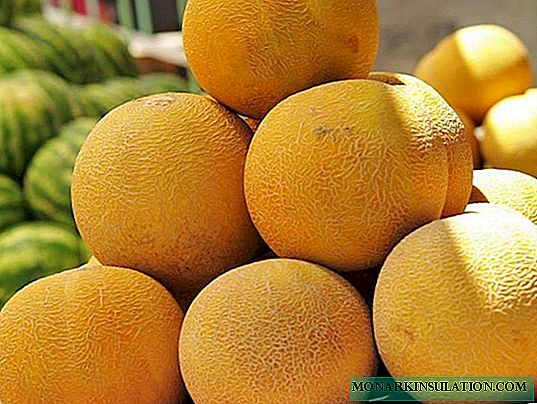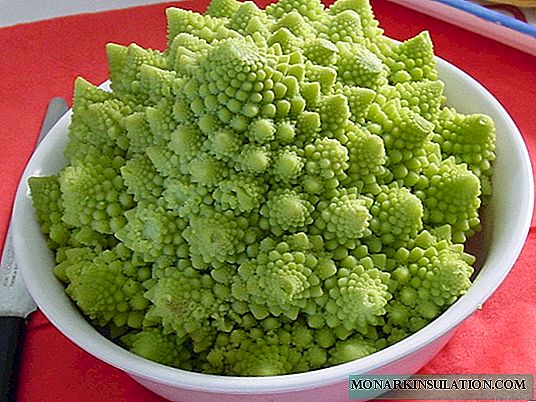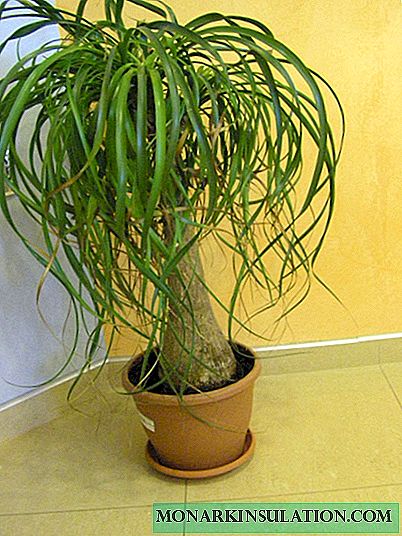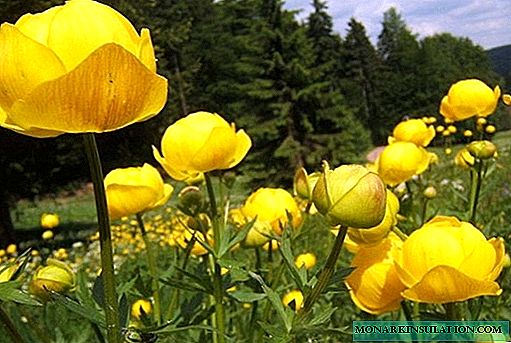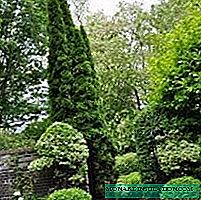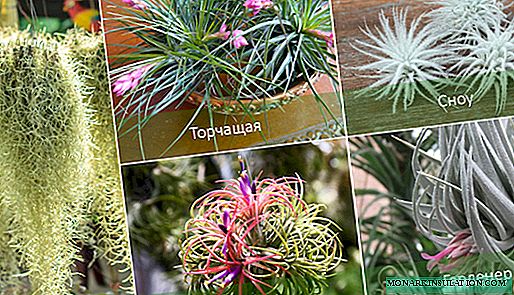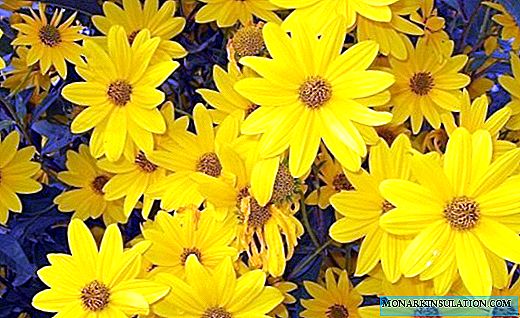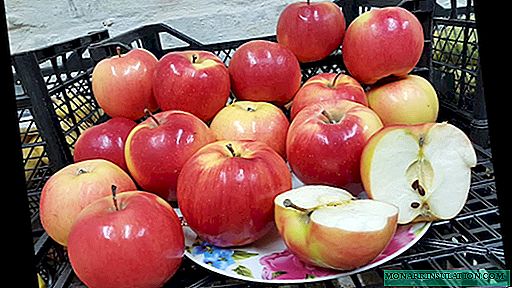
In recent years, the Polish apple variety Ligol, which will soon be 50 years old, has begun to gain popularity in Central Russia. It is useful to find out what caused the interest of gardeners. And also it will be useful to get acquainted with the features of the agricultural technology of the variety.
Grade description
Ligol is a late winter variety of Polish selection, bred in 1972 for industrial gardens. Since 1995, it has been grown in Ukraine, and in 2017 it was included in the State Register of Russia for the Central Black Earth Region. Originator LLC "Gardens of Belogorye" from the Belgorod region. The variety is popular in industrial gardens of the southern regions of Russia, amateur gardeners are grown in many areas of the Middle lane.
Originator - an individual or legal entity that created, bred, or revealed a plant variety or animal breed and (or) ensures its conservation, but is not a patent holder.
Wikipedia
//ru.wikipedia.org/wiki/Originator
Has a fast-growing large tree with a wide-pyramidal crown of medium density. They are grown on tall, medium and dwarf rootstocks. Flowering periods - medium, duration - 7-10 days. It has good winter hardiness, drought resistance and medium heat resistance. Ligol has high immunity to scab and powdery mildew, but there is a risk of a bacterial burn and European (ordinary) apple tree cancer.
The early maturity of a tall tree is at the level of 6-7 years, medium-sized - 4-5 years, low-growing - 3-4 years. In the early years, the crop is small - 4-5 kilograms. With age, fruit bearing increases rapidly and 4-5 years after the start of fruiting in industrial gardens, an average of 336 c / ha is already received. With proper care and rationing of the crop - annual fruiting. Self-infertile. As pollinators suitable varieties:
- Idared
- Gloucester
- Champion;
- Spartan
- Golden Delicious;
- Mac;
- Fuji and others.
Fruits are round-cone-shaped of regular shape with a highly ribbed surface, one-dimensional. The average weight of an apple is 210 grams, the maximum is 300 grams. Individual fruits can reach a mass of 400 and even 500 grams. The peduncle is short and thick. The strength of the apples is strong. The main color is greenish, the integument is carmine-red, blurry, occupying most of the surface. The hypodermic points are gray and medium in size. They are numerous, but hardly noticeable. The flesh is cream-colored, dense, rough, coarse-grained, juicy. The taste of apples is sour-sweet, pleasant. The aroma is medium. Tasting score - 4.8 points. The purpose of the fruit is universal, transportability is good. Harvest fruits in late September, and they fully ripen in January. The refrigerator is stored for up to six months. The originator of the variety declares on its website a shelf life of 9 months.

Fruits Ligol round-cone-shaped regular shape with a highly ribbed surface, one-dimensional
Summarizing, the following merits of the variety can be noted:
- frost resistance;
- drought tolerance;
- resistance to scab and powdery mildew;
- early maturity;
- the taste of fruits;
- long shelf life.
Disadvantages:
- insufficient immunity to European (ordinary) cancer of apple trees and bacterial burns;
- fruiting frequency is sometimes observed.
Video: review of the apple tree Ligol
Planting Ligol apple trees
To obtain maximum productivity of the apple tree, she needs to create favorable conditions. Ligol apple trees grow well on loam, sandy loam and black soil. For planting, choose an open, well-lit, ventilated place. At the same time, it should not be blown by cold northerly winds and drafts. It is best to have dense plantations of tall trees or building walls, fences from the north or northeast. The occurrence of groundwater should be quite deep (at least two to three meters), waterlogging and stagnation of water are not allowed. The soil for the apple tree needs loose and well-drained soil with a pH of 5.0-6.5 (slightly acidic or normal).
If there is a suitable place for growing an apple tree, it remains only to buy a seedling and determine the date of planting. Experienced gardeners do not postpone the purchase of seedlings in the spring. They always do this in the fall, because at this time in nurseries there is always a large selection of high-quality planting material. And it doesn’t matter if the planting is planned for spring (and this is the best time for planting) - the seedling will successfully winter in the basement or dug into the ground. It is only necessary not to forget to dip the roots into a mash of clay and mullein before laying it for storage - so they will not dry out.

Before laying seedlings for storage, you need to dip the roots into a mash of clay and mullein - so they will not dry out
Step-by-step landing instructions
So, the place has been chosen, the seedling has been purchased, now you can begin the process of planting an apple tree:
- In autumn you need to prepare a landing pit. For this:
- Dig a hole 60-80 centimeters deep and 100-120 centimeters in diameter, laying fertile soil to the side.
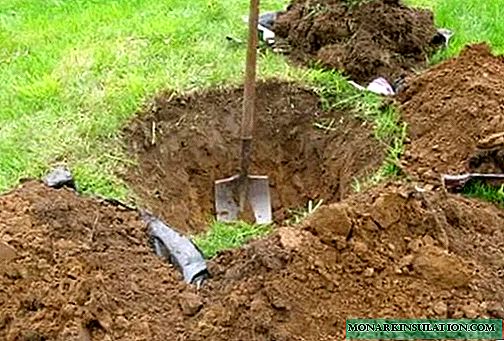
Dig a hole 60-80 centimeters deep and 100-120 centimeters in diameter, laying fertile soil to the side
- On heavy soils, drainage is required, as a layer of crushed stone (expanded clay, broken brick, etc.) with a thickness of 10-15 centimeters is laid at the bottom.
- Fill the pit with a mixture of chernozem, humus, peat and coarse sand in a ratio of 2: 2: 1: 1. On each bucket of such a mixture pour 30-40 grams of superphosphate and 0.5 liters of wood ash.
- Dig a hole 60-80 centimeters deep and 100-120 centimeters in diameter, laying fertile soil to the side.
- Sapling roots are soaked in water a few hours before planting. A root stimulant (Kornevin, Epin, Heteroauxin) is added to the water.
- A hole is dug in the center of the landing pit, at the bottom of which a small mound is formed.
- Having departed from the center 10-15 centimeters, a wooden stake is hammered. Its height above the ground should be between 0.9-1.3 meters.
- The seedling is lowered into the hole and placed with the root neck on the top of the knoll. The roots are neatly spread and placed on the slopes of the mound.
- They fill the hole with earth in layers, gently ramming it.
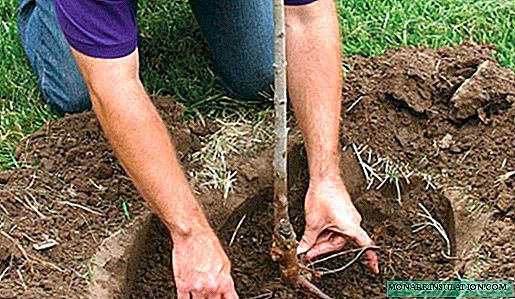
They fill the hole with earth in layers, gently ramming it
- With a chopper or a plane cutter, an earthen roller is raked along the diameter of the landing pit to hold water during irrigation.
- To prevent the young tree from falling under the influence of the wind, tie its trunk to the peg with a soft cloth tape.
- Abundantly water the landing pit in several stages. As a result, all the soil in it should be well moistened and fit snugly to the roots, leaving no air bosoms.
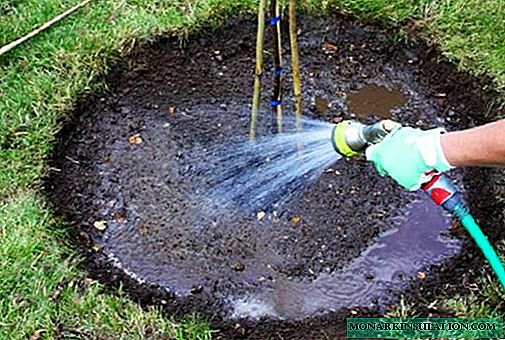
After planting, the landing pit is abundantly watered in several stages
- The seedling is cut to a height of 0.9-1.1 meters, the branches are cut in half.
- At the end of the process, the soil in the near-stem circle is loosened and mulched. To do this, you can use humus, compost, hay, straw, etc.
Features of cultivation and subtleties of care
Since care of the Ligol apple tree is not much different from caring for apple trees of other varieties, we will briefly dwell on the main points and stages.
How to water and fertilize
Since the variety is drought tolerant, little watering will be needed. It is important to water the apple tree before flowering, after flowering and once or twice in the summer during the period of growth of fruits and young shoots. And also need pre-winter water-charging irrigation. These rules apply to adult apple trees with a developed root system. Up to seven to eight years old, watering occurs more often - up to 8-10 waterings per season. After each irrigation, the soil of the near-stem circle should be loosened to provide oxygen access to the roots. If the soil is mulched, the intervals between irrigation can be increased, and loosening is excluded.
Three to four years after planting, the apple tree will need additional nutrition.
Table: Fertilizer schedule for Ligol apple tree
| Term | Fertilizers | Dosage and route of administration |
| April | Humus, compost | 5-10 kg / m2 evenly sprinkle on the surface of the trunk circle and dig. Organics must be added regularly at least once every three to four years. |
| Ammonium nitrate or urea | 30-40 g / m2 sprinkled on the surface of the trunk circle and watered | |
| First half of June | Potassium monophosphate | 10-20 g / m2 dissolved in water and watered the soil of the trunk circle |
| June July | Liquid organic infusions. A concentrate is prepared by infusing two liters of mullein in a bucket of water. Mullein can be replaced with bird droppings, which will require half as much. | 1 l / m2 dissolved in water and water the plant |
| October | Superphosphate | 30-40 g / m2 under digging |
| Periodically, you need to make complex mineral fertilizers with a set of trace elements. They are used in accordance with the instructions attached to the fertilizer. | ||
Crown shaping and trimming
An important stage in the cultivation of an apple tree is the formation of its crown. Nowadays, they try to avoid tall trees, so Ligol is more common on mid-sized and dwarf rootstocks. For trees of this growth, grown traditionally, a cup-shaped crown formation is used. Increasingly, there is a method of growing apple trees on trellises, in which case they usually resort to palmette type formation. Also, spindle-type formation is gaining popularity. In any case, they begin to form at the time of planting a seedling and carry it out for three to four years. The term for forming pruning is early spring before the onset of sap flow.

The formation of the crown of apple trees as a spindle is gaining popularity
It is equally important to maintain abundant fruiting to regularly thin out the crown, while cutting shoots growing inward and upward, as well as crossing and interfering with each other. This pruning is called regulatory and is also carried out in spring.
We should not forget about sanitary pruning, which is traditionally carried out in the fall after the end of leaf fall. At the same time, all dry, diseased and damaged branches are cut out.
How to collect Ligol apples and store them
Before you start picking apples, you need to wait for stable dry weather so that the fruits on the tree are dry. Harvested wet apples will not be stored for very long. During the collection, the fruits should be sorted, discarding damaged ones, which can be immediately recycled for juice. For storage, suitable fruits are placed in cardboard or wooden boxes. It is better to arrange the apples in one row so that they do not touch each other. But it is possible in several rows, shifting them with paper or rye straw. Apples will be stored longer at temperatures between 0- + 5 ° C and at least 85% humidity, while boxes should be stacked on top of each other through four centimeter thick gaskets to provide ventilation.
Diseases and Pests
Modern varieties, which include Ligol, are less susceptible to disease and pest attack. However, often immunity does not apply to all diseases. Therefore, the timely and regular implementation of preventive and sanitary measures should not be neglected in any case.
Disease and Pest Prevention
The list of preventive work is familiar to any experienced gardener. For starters, we give it briefly:
- Every year in the fall, it is necessary to collect fallen leaves and burn them along with the branches left after sanitary pruning. At the same time, the spores of pathogens, wintering pests are destroyed, and as a bonus, the gardener receives a certain amount of wood ash, which is a valuable fertilizer.
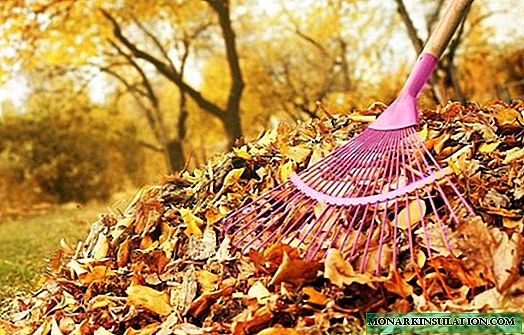
Fallen leaves may contain fungal litter and wintering pests.
- At the same time, it is necessary to inspect the bark of the tree and if cracks of damage are detected, they should be cleaned and cut to healthy wood. Then treat with 1% solution of copper sulfate and cover with a layer of garden var. The same thing needs to be done in the spring, when after the winter frost bumps and sunburns can appear on the bark. These actions are aimed at the prevention of European (ordinary) cancer of apple trees and other possible diseases of the bark.
- The whitewash of the trunk and thick branches of the apple tree with a solution of slaked lime with the addition of copper sulfate (1-2%) and PVA glue is aimed at the prevention of sunburn and frost-bumps.
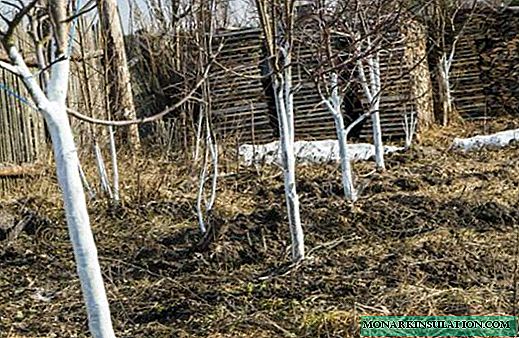
Trunks and thick branches of apple trees are bleached with lime mortar
- Deep digging of the soil of the near-trunk circle before the onset of frost will allow to raise pests wintering in the soil to the surface. As a result, most of them will die from the cold.
- Strengthening the effect of the previous event will allow spraying the soil and tree crown with a 3% solution of copper sulfate or Bordeaux mixture.
- In early spring, an eradicating treatment with DNOC or Nitrafen should be carried out, aimed at the prevention of all known fungal diseases and pests. It should not be forgotten that the use of DNOC is allowed no more than once every three years.

The first spraying of apple trees is carried out in early spring
- At the same time, it is worth installing a hunting belt on the trunk of the apple tree, which can be made from improvised material. It will prevent the crawling of ants, caterpillars, bugs, etc. on the crown.
- To prevent fungal diseases and pests, three treatments are done. The first is carried out before flowering, the second - after flowering, and the third - after 7-10 days after the second. Of fungicides (drugs to combat fungal diseases) at this time, the most effective are Horus, Skor, Ridomil Gold. Insecticides (insecticides) - Decis, Fufanon, Spark-Double effect.
Bacterial burn (bacteriosis)
The name of the disease was due to the similarity of symptoms with sunburn of leaves as a result of drought. But if you look closely, you can find a number of differences in these lesions. This is important for diagnosis.
Table: signs of bacterial and sunburn of leaves of apple trees
| Plant parts | Condition of plant parts | |
| With bacteriosis | With sunburn | |
| Leaves | Reddish necrotic areas spread between veins to the periphery of the leaf | Leaf mortification begins at the edges and advances towards the middle of the leaf in the form of brown spots. |
| Shoots | With the development of dry shoots, they fade and bend | Shoots, dying, remain straight |
| Bark | The bark becomes sticky and moist. On its surface, white exudate is distinguished, which gradually becomes brown. | Dry bark, no exudate |
| Flowers, ovaries and fruits | Buds and flowers die off, getting a dark brown color. However, they do not fall and remain on the branches. The darkened ovaries stop growing. The fruits are covered with exudate, mummified and remain on the tree for more than a year. Their color is black. | Buds, flowers, ovaries dry and crumble |
Exudate (in this case) is the fluid released from the tissues of the leaves of a tree when it is affected by diseases.
Since the causative agent of the disease is a bacterium, it should be combated with antibiotics. The following drugs are used for spraying:
- Ampicillin - one ampoule per bucket of water.
- Fitolavin - 20 ml per bucket of water.
- Three tablets of Tetracycline and one ampoule of Streptomycin are dissolved in five liters of water.
For the treatment of wounds and bandages use:
- A solution of one ampoule of Gentomycin in one liter of water.
- A solution of one Ofloxacin tablet in one liter of water.
Often, bacteriosis is spread by a fungal pathogen of moniliosis, so fungicides should be used simultaneously with antibiotics. Effective preparations are Strobi, Skor, Chorus and others.

Bacteriosis can infect an entire garden
European (ordinary) apple cancer
This disease is more often observed in the southern regions of Russia and in the Crimea. The pathogen fungus penetrates into the tissue of the tree through damage to the bark, frost, burns, cuts of branches, unprotected by garden var. With damage to the trunks, open wounds are formed. At their edges appear extensive floods, which are called callus. On small wounds, the edges of the callus are fused and the disease proceeds closed.Prevention - prevention of burns, frost, the appearance of cracks and their timely treatment in case of occurrence. Cancer treatment is simple - it is the same as with any lesions of the cortex. The wound is cleaned and cut to healthy wood, disinfected and covered with a layer of a garden var.

When an apple tree is damaged by European cancer, open wounds form on the trunk and branches
Possible pests of the apple tree Ligol
Subject to sanitary and preventive measures, the defeat of the apple tree Ligol by pests is practically excluded. In the garden, where prevention has been neglected, some pests may attack.
Apple moth
This is a small (up to three centimeters) night butterfly, flying for 30-45 days in springtime. From the eggs laid by her in the crown, the caterpillars creep up to 18 mm long, which penetrate into the ovaries and fruits, where they feed on seeds. There are no ways and methods to control the caterpillar, therefore, preventive measures should not be neglected.

Moth caterpillar feeds on the seeds of the fetus
Apple Blossom
Safely wintered in the upper soil layers of the near-stem circle, a small (up to three millimeters) weevil beetle rises to the crown. There, his female cuts a flower bud and lays an egg in it. After that, a larva will inevitably appear from the egg, which will eat the flower from the inside. At this stage, you can still urgently spray the crown with insecticides (Decis, Spark, Fufanon) to save intact flowers and preserve part of the crop. But it is better not to bring to this and carry out preventive treatments in advance.

Flower beetle larva eats a flower from the inside
Gall aphid
This is one of the few pests of the apple tree, which can be combated after its attack. Having found aphids on the leaves of an apple tree, one should cut off the twisted leaves and the affected ends of young shoots. After this, you need to spray the crown with a biofungicide, for example, Spark Bio. And do not forget that aphids are usually carried on a tree by ants in order to subsequently feed on its sweet secretions (the so-called honey dew). And they could be stopped very simply by installing a hunting belt.

Aphids settle on the underside of leaves
Gardeners reviews
Re: Ligol (Ligol) The taste is really good, ate. There is a desire to plant.
Camilla, Ternopil, Ukraine
//forum.vinograd.info/showthread.php?t=11275
Re: Ligol A delicious apple, a very big difference in the taste of the store ones and from your garden, the variety is really frost-resistant and high-yielding, the apples themselves are very attractive. 5 years without comment.
fantoci, Kiev
//forum.vinograd.info/showthread.php?t=11275
Re: Ligol (Ligol) Winter hardiness is normal. I have bloomed. Ovary dropped. Flowering was the first - accordingly, the grade has not yet been confirmed.
f
//forum.vinograd.info/showthread.php?t=11275
Good evening, in my garden, the Ligol variety on m-9 for the fourth year produced 30 kg of apples of excellent quality, but it was necessary to harvest in 2, or even 3, parishes.
Lina-G, Kremenchug, Ukraine
//forum.vinograd.info/showthread.php?t=11275&page=4
Posted by Tanja I really like Ligol apples. I’m thinking of planting in the country ... Maybe someone is growing, tell me whether it’s worth it?
It’s worth planting this variety! I grow about 20 varieties of apple trees and Ligol is one of the best! It is both fruitful and beautiful and tasty and the apple is very large, in addition, it does not become soft for a long time. Very tight and juicy!
Helgi, Kiev region
//www.sadiba.com.ua/forum/showthread.php?p=466316
Minor flaws of the Ligol apple variety are more than overlapping with undeniable advantages. The first to appreciate this fact were enterprising farmers who were actively engaged in cultivating varieties on their farms with the goal of making a profit. Behind them tightened up and more inert amateur gardeners. You can confidently recommend Ligol for growing in your garden along with other interesting varieties.








